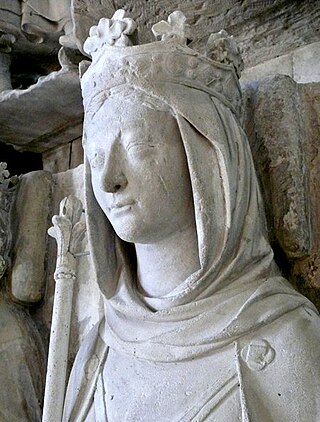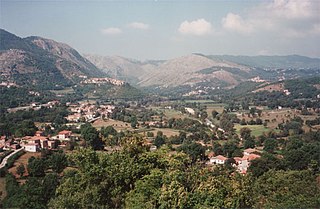
Carloman I, also Karlmann, was king of the Franks from 768 until his death in 771. He was the second surviving son of Pepin the Short and Bertrada of Laon and was a younger brother of Charlemagne. His death allowed Charlemagne to take all of Francia and begin his expansion into other kingdoms.

Desiderius, also known as Daufer or Dauferius, was king of the Lombards in northern Italy, ruling from 756 to 774. The Frankish king of renown, Charlemagne, married Desiderius's daughter and subsequently conquered his realm. Desiderius is remembered for this connection to Charlemagne and for being the last Lombard ruler to exercise regional kingship.

Richard Hodges, is a British archaeologist and past president of The American University of Rome. A former professor and director of the Institute of World Archaeology at the University of East Anglia (1996–2007), Hodges is also the former Williams Director of the University of Pennsylvania Museum of Archaeology and Anthropology in Philadelphia. His published research primarily concerns trade and economics during the early part of the Middle Ages in Europe. His earlier works include Dark Age Economics (1982), Mohammed, Charlemagne and the Origins of Europe (1983) and Light in the Dark Ages: The Rise and Fall of San Vincenzo Al Volturno (1997).

Ermentrude of Orléans was the Queen of the Franks by her marriage to Charles II.

East Francia or the Kingdom of the East Franks was a successor state of Charlemagne's empire ruled by the Carolingian dynasty until 911. It was created through the Treaty of Verdun (843) which divided the former empire into three kingdoms.

Boso was a Frankish nobleman of the Bosonid family who was related to the Carolingian dynasty and who rose to become King of Lower Burgundy and Provence.

Arechis II was a Duke of Benevento, in Southern Italy. He sought to expand the Beneventos' influence into areas of Italy that were still under Byzantine control, but he also had to defend against Charlemagne, who had conquered northern Italy.

The Valle di Comino is a valley in the province of Frosinone, in Lazio in central Italy. It runs from San Biagio Saracinisco to Vicalvi and is adjacent to the Abruzzi mountains. It grossly corresponds to the upper valley of the Melfa river, which runs through it before joining the Liri.

Capestrano is a comune and small town with 885 inhabitants (2017), in the Province of L'Aquila, Abruzzo, Italy. It is located in the Gran Sasso e Monti della Laga National Park.
Gisulf I was the duke of Benevento from 689, when his brother Grimoald II died. His father was Romuald I. His mother was Theodrada, daughter of Duke Lupus of Friuli, and she exercised the regency for him for the first years of his reign.

Ansa or Ansia was a Queen of the Lombards by marriage to Desiderius (756–774), King of the Lombards.

Christopher John Wickham is a British historian and academic. From 2005 to 2016, he was the Chichele Professor of Medieval History at the University of Oxford and Fellow of All Souls College, Oxford; he is now emeritus professor. He had previously taught at the University of Birmingham from 1977, rising to be Professor of Early Medieval History from 1997 to 2005.
Gerberga was the wife of Carloman I, King of the Franks, and sister-in-law of Charlemagne. Her flight to the Lombard kingdom of Desiderius following Carloman's death precipitated the last Franco-Lombard war, and the end of the independent kingdom of the Lombards in 774.

San Salvatore is a former monastery in Brescia, Lombardy, northern Italy, now turned into a museum. The monastic complex is famous for the diversity of its architecture which includes Roman remains and significant pre-Romanesque, Romanesque and Renaissance buildings.

San Vincenzo al Volturno is a historic Benedictine monastery located in the territories of the Comunes of Castel San Vincenzo and Rocchetta a Volturno, in the Province of Isernia, near the source of the river Volturno in Italy. The current monastery, housing a group of eight Benedictine nuns, is located to the east of the river, while the archaeological monastery of the early Middle Ages was located on the west.

Longobards in Italy: Places of Power is seven groups of historic buildings that reflect the achievements of the Germanic tribe of the Lombards, who settled in Italy during the sixth century and established a Lombard Kingdom which ended in 774 A.D.
Megingoz was the second bishop of Würzburg from 753 until his retirement in 768.

The Carolingian Cross is but one variation in the vast historical imagery of Christian symbolic representations of the Crucifixion of Jesus, going back to at least the ninth century. All crosses and Christian symbols have an inherent meaning arising from a multitude of sources and distinct features that set them apart from other religions. From both a design aspect and a theological perspective, the Carolingian Cross consists of a mixture of Christian and pre-Christian concepts built over a long history of cultural adaptation, religious iconography, liturgical practices and theological premises. German graphic designer Rudolf Koch in 1932 published a collection of 158 plates of drawings of Christian symbols. Under the heading of "Cross", this includes twelve drawings of Christian cross variants. One of these, the "Carolingian Cross" shows a cross of four triquetras.
Transformation of the Roman World was a 5-year scientific programme, during the years 1992 to 1997, founded via the European Science Foundation. The research project was to investigate the societal transformation taking place in Europe in the period between Late Antiquity up to the time of the Carolingian dynasty. The results were presented in museal exhibitions and as well published in a book series carrying the same name as the project. Contributors to the series include Walter Pohl, Richard Hodges, Bryan Ward-Perkins, Ian Wood, Mayke de Jong, Janet Nelson, Chris Wickham, Miquel Barceló, Hans-Werner Goetz, and Jörg Jarnut.
Kimberly D. Bowes is an American archaeologist who is a professor of Classical Studies at the University of Pennsylvania. She specializes in archeology, material culture and economics of the Roman and the later Roman world. She was the Director of the American Academy in Rome from 2014–2017. She is the author of three monographs.